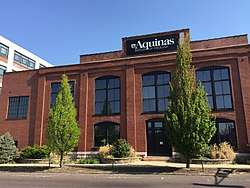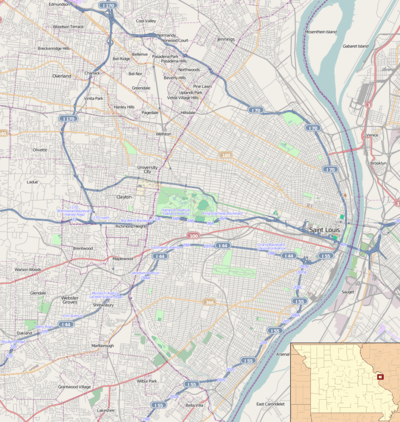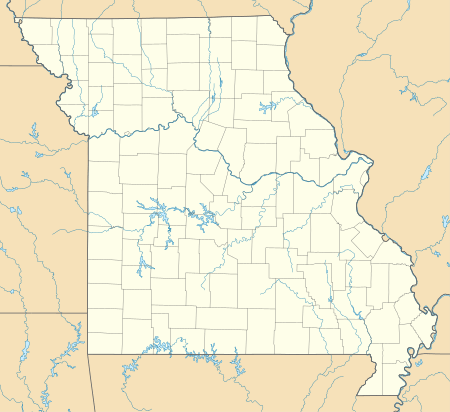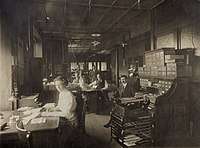Standard Adding Machine Company
Standard Adding Machine Company was founded in the early 1890s (first records are from 1892)[2][3][4] in Illinois and was the first company to (successfully)[5] release a 10-key adding machine. The machine was a breakthrough for its time because it dramatically modernized computing. Earlier key driven adding machines, like the comptometer, featured eight or more columns of nine keys, which made them cumbersome and costly and their operators prone to mistakes. The 10 keys were set on a single row.
Standard Adding Machine Building | |
 The building of Standard Adding Machine Company was renovated, and is now the home of Aquinas Institute of Theology | |
   | |
| Location | 3701 Forest Park Blvd., St. Louis, Missouri |
|---|---|
| Coordinates | 38°38′9″N 90°14′17″W |
| Area | less than one acre |
| Built | 1903 |
| Architect | G.N. Hinchman |
| Architectural style | Industrial |
| NRHP reference No. | 05001328[1] |
| Added to NRHP | November 25, 2005 |

The invention won an international grand prize during the 1904 World's Fair and was heralded as a "modern life preserver" in an office journal.
History
William H. Hopkins, the inventor of the Standard Adding Machine, was a minister. When he moved to St. Louis in 1885 he served as chaplain and then pastor of St. Louis Second Christian Church. He continued to invent during those years and to find better ways to make an adding machine. In the 1890s, he left Second Christian Church and became assistant editor of the company that published The Christian Evangelist. William Hopkins filed his first patent on October 4, 1892. He registered the Hopkins Adding Machine Company in 1897,[6] and in 1899 his company changed name to Standard Adding Machine Company (Illinois company was bought off).[7][8]
The Standard Adding Machine Company released the first 10-key adding machine in about 1900.[9] Hopkins' success led to competition. By 1915, other adding machine companies were vying for business. In 1916, Hopkins died, and his company began to decline.
Standard Adding Machine closed in 1921. In the decades since, the building housed businesses such as St. Louis Pump & Equipment Co., Lee Paper Co., and most recently, Harrison-Williams Store Fixtures. Vacant since 2003, the building was renovated in 2005 by Aquinas Institute of Theology.
Recognition
Because of the historical significance of the adding machine, the Standard Adding Machine building is listed on the National Register of Historic Places.
Notes
- "National Register Information System". National Register of Historic Places. National Park Service. July 9, 2010.
- "Projected Illinois Business Corporations (Jan. 20.)". The National Corporation Reporter. United States Corporation Bureau, inc. 3 (21): 414. 1892 – via HathiTrust.
- Hopkins, William. "Patent US517383". Google Patents. Retrieved 2017-09-09.
- The Age of Steel (Iron and machinery world). 71. Journal of Commerce Company, Publishers and Proprietors. 1892. p. 16.
- There's indication that at least one person (William F. Gatewood) tried to do that earlier: patent (1887), advertisement (1892).
- "St. Louis and vicinity". The Age of Steel (Iron and Machinery World). LXXXI (81) (17): 22. 1897 – via HathiTrust.
- "St. Louis and vicinity". The Age of Steel (Iron and Machinery World). LXXXV (85) (24): 24. 1899 – via HathiTrust.
- "Stockholder's Meeting". Christian Evangelist. LXXXVI (86). Disciples Divinity House of the University of Chicago. Christian Publishing Co. June 1899. p. 703.CS1 maint: others (link)
- Iowa. (1901). "Treasurer of State. Statement of office furniture and stores". Report of the Executive Council of Iowa of Expenses and Disposition of Fees and Moneys Collected by State Officers and Institutions ...: 71 – via HathiTrust.
External links
- rechenmaschinen-illustrated.com Picture of an early Standard machine.
- Freemasons. (1901). "The Standard Adding Machine - advertisement". Grand Lodge Bulletin. IV (4): 108 – via HathiTrust.
- "St. Louis City National Register Listings". dnr.mo.gov. Missouri Department of Natural Resources. Archived from the original on May 4, 2006. Retrieved 10 September 2017.CS1 maint: others (link) Alt URL